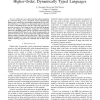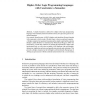218 search results - page 4 / 44 » Types and trace effects of higher order programs |
WCRE
2005
IEEE
13 years 11 months ago
2005
IEEE
— Chuck is a new code browser that allows navigation of a code base along semantic structures, such as data-flow and higher-order control-flow relationships. Employing the fast...
PPCP
1993
13 years 9 months ago
1993
Higher-order logic programming (HOLP) languages are particularly useful for various kinds of metaprogramming and theorem proving tasks because of the logical support for variable ...
TLCA
2007
Springer
13 years 12 months ago
2007
Springer
A Kripke Semantics is defined for a higher-order logic programming language with constraints, based on Church’s Theory of Types and a generic constraint formalism. Our syntactic...
FROCOS
2011
Springer
12 years 5 months ago
2011
Springer
Many functional programs and higher order term rewrite systems contain, besides higher order rules, also a significant first order part. We discuss how an automatic termination p...
KI
1990
Springer
13 years 9 months ago
1990
Springer
ue to a lack of abstraction in the formalization of deductive mechanisms involved in programming reasoning tools for the development of program synthesizers are not yet available. ...


